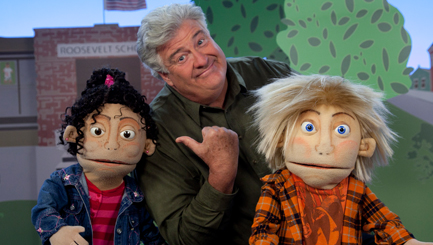Produce Your Own Puppet Shows
Get creative with your own Stepping On Up productions!
- Make your own puppets
- Download the Stepping On Up program scripts
- Put On Your Own Puppet Shows
Make Your Own Puppets
Puppets come in all shapes and sizes. The puppets we used for our video programs are muppet type puppets and can take some time, energy and skill to make. A simpler approach is to make sock puppets and decorate them with yarn to make distinctive hair for our characters (yellow for Dieter, brown for Zazi). There are a lot of places on the Web with instructions for making puppet, but they all involve adult supervision, so make this a class activity. Here are some suggestions for making sock puppets:
- http://www.wikihow.com/Make-a-Sock-Puppet
- http://www.daniellesplace.com/html/puppets.html
- http://www.legendsandlore.com/sockpuppets.html
Program Scripts
We will be posting full program scripts which correspond to our Clip of the Month and provide the basis of many of the activities included here. Download full scripts for the following lessons from our Stepping Up To Bullying DVD and use for your own live puppet shows.
Dealing with Bullies Script (pdf) »
Standing Up, Not Standing By Script (pdf) »
Reaching Out To Victims Script (pdf) »
Building Bully-Free Schools/Communities Script (pdf) »
(These scripts are copyrighted material and are for non-commercial educational and personal use only.)
STAGING YOUR PLAY
Once you have made your puppets and have downloaded some scripts, you are ready to produce your own puppet shows. Follow these steps to bring your production to life.
- Create your stage. The easiest way to create a stage is to use a large folding or stationary table (2.5″ x 5″ or larger) from school and drape some cloth across the front to hide the puppeteers. If you are more ambitious, you can also make your own puppet theater by following directions from these Websites:
- Cast two student puppeteers who have strong arms and flexible shoulders who can operate the puppets from below the table top from a kneeling position on pads or from short stools.
- Cast two student voice actors who can read the parts of Dieter and Zazi
- Ask your teacher to read Michael Pritchard’s part for Act Two
- Rehearse, rehearse, rehearse. This is show business!
HOW TO PRESENT YOUR PLAY IN CLASS
Once you are ready to perform for your class, use the How To Use This Program section in the Leader’s Guide page to create a complete class lesson with your puppet show. Here are the basics:
- Introduce lesson
- Present Act One of lesson
- Lead group discussion
- Present Act Two of lesson
- Extend lesson through follow-up discussion and activities
Work with your teacher to decide which of the questions and activities you would like to use for your presentation.
Good Luck. Consider videotaping your puppet show and posting it in YouTube, or send it along to us, so we can post it.
Follow-Up Activities for Stepping Up to Bullying
Each month we will publish follow-up activities for the lesson featured in the Clip-of-the-Month. Here are some suggested activities from our Stepping Up to Bullying DVD, which includes this month’s clip.
Activites
Students may wish to write their own scripts revolving around situations in their own lives; both sides of how a situation did play out, and how the situation might have played out in a positive way. It can be a class activity to write and produce these puppet shows.
Following the example of Dieter and Zazi, create your own school/community-wide campaign to stop bullying. Brainstorm your plan in class. Here are some starter ideas:
Write a class/school pledge to stop bullying and not be a bully or a bystander. Put it on a large piece of butcher paper and have students sign it.
Hold essay writing contests on bullying and publish the results on your school Web site.
Create the two buttons Zazi describes in Lesson 4 that say either Bully or Up-stander and let students decide which one they want to wear.
Create a series of posters for your group, classroom or school/community center that:
- Illustrate different types of bullying
- Demonstrates the difference between friendly kidding and hurtful teasing
- List good things to do when being bullied
- List good things bystanders can do to help stop bullying
- Show easy ways to report bullying
- Illustrate ways your school/community can be more caring and inclusive
Debate these questions in your group, class or at a school/community-wide assembly:
- True or false: The problem of bullying is greatly exaggerated by the media and is not as common as most people believe.
- True or false: Only physical acts of violence should be considered bullying because people get their feelings hurt all the time and it is not a big problem.
- True or false: When you are having problems at school, is it more important to talk to an adult about it or stay quiet so no one gets in trouble?
- True or false: Victims of bullying are not blameless. They often do things that annoy and anger people and so can cause bullying themselves.
- True or false: Teasing is harmless fun and we should not have to stop it, even if it occasionally hurts someone’s feelings.
- True or false: Bullying will never stop because it is part of human nature and you cannot change the way people think and act.
Have the students make simple sock puppets and mime puppets’ movements to the audio of the programs. Teams of students can perform Act One of the skits for other classes and lead problem-solving discussions based on their performances. You can find simple instructions for making puppets on the Internet by entering sock puppets or making puppets in your browser or search engine.
